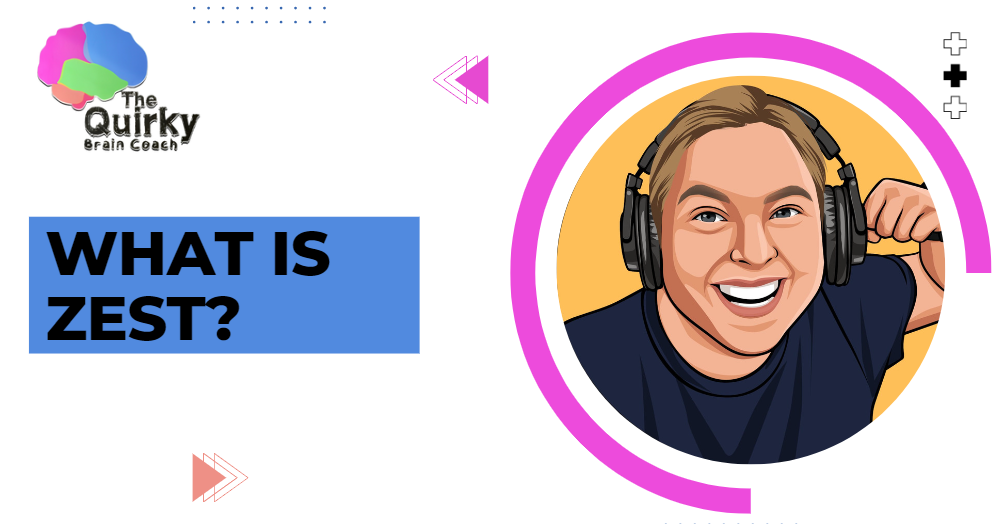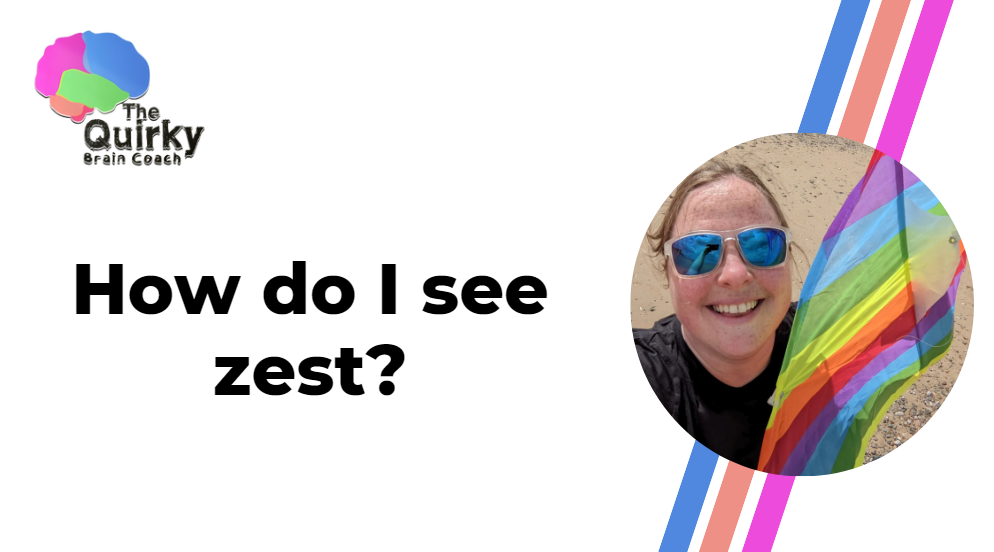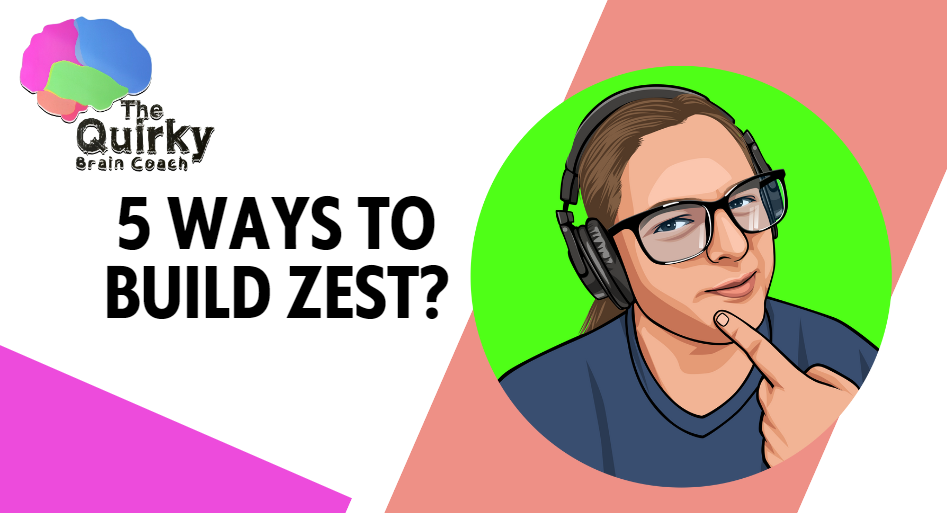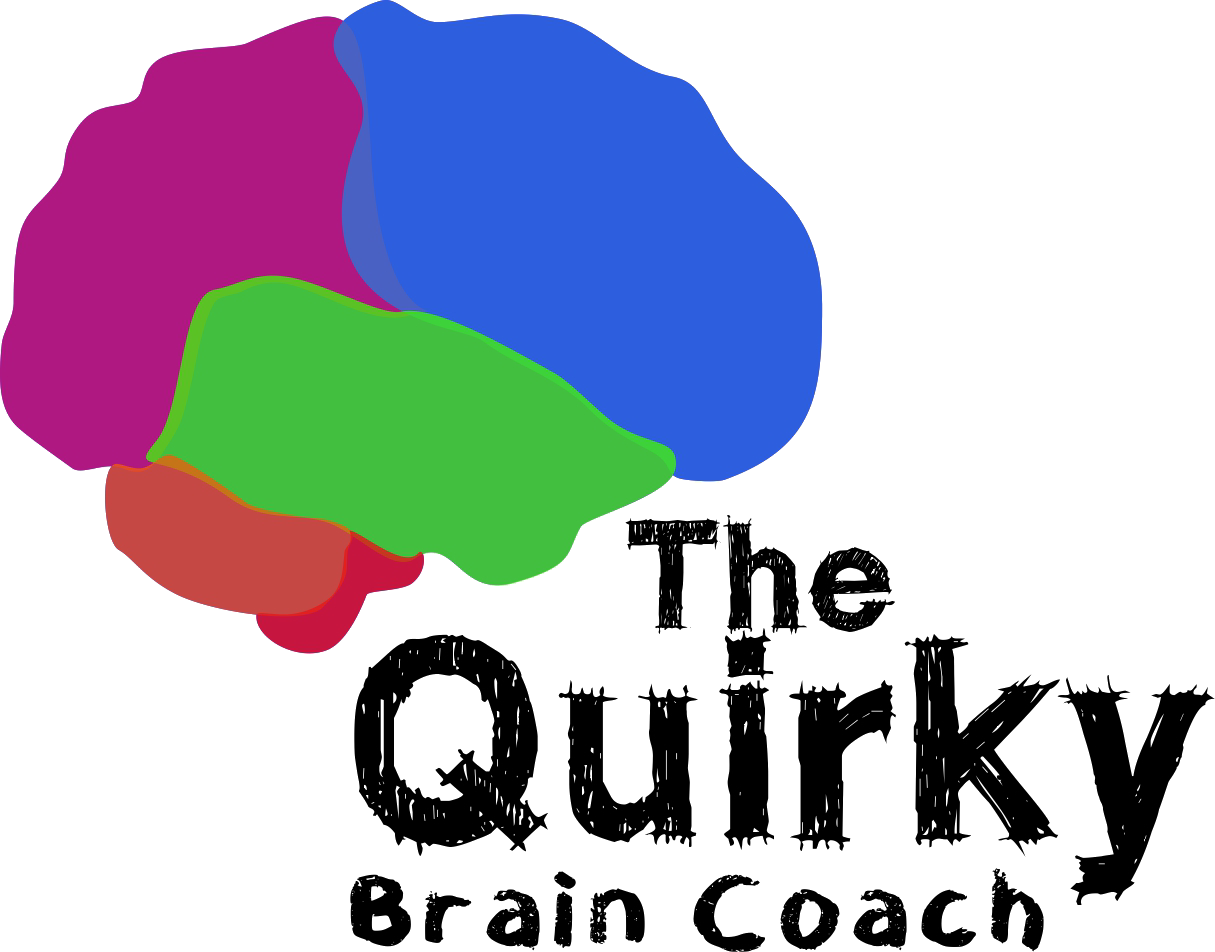An introduction to zest and 5 ways to build it
It occurred to me that I am a coach who not only studies zest but works on it A LOT for myself and with clients BUT I have not written an introduction to zest or how to build it yet!
This post rectifies this gap in my resources. Welcome to neurodivergent zest 101!
In this post, I’ll talk to you about what zest is, why it benefits us, how zest relates to neurodivergence, and 5 ways that you can build your zest levels if you choose. Let’s kick off by defining zest and also getting my professional opinion on what it is.
Positive psychology can be thought of as the art and science of wellbeing (Haidt, 2005).
Positive psychology coaching is about using models, frameworks and concepts from the psychology of wellbeing in coaching.
One of the positive psychology coaching concepts I explore a lot with my coaching clients is zest. So what is it?

What is zest?
Zest is considered a character trait in positive psychology. According to the VIA Institute of Character (2024), zest is about energy, enthusiasm, and excitement – in particular an excitement for life.
Someone who feels zesty might say things like “I feel full of energy and I’m so excited to do that thing”. Zest is sometimes also referred to as vitality, so you might see that word floating around too – but the terms are fairly interchangeable.
The VIA Institute of Character (2024) also note that zest is connected to physical and psychological wellbeing, and I agree but in a particular way. I will unpack this more shortly.
As I mentioned, zest is widely considered a character trait or, more specifically, a strength in positive psychology literature. I disagree with the view that zest is a typical strength. Let me tell you why.
For other strengths, it’s really clear to see what mostly controllable behaviours a person can do to exhibit or develop that strength. For example, to be brave, you have to do something hard or scary in the face of challenge. To use your strength of kindness, you have to do something nice for another person. To draw on a strength in humour, you would intentionally make others laugh by telling jokes or a funny story.
What do you do to exhibit zest in a similar way? I’m not sure. We might say “get stuck in”, but that’s quite vague and may not be an inclusive or accessible way of looking at things. In any case, this argument is enough to suggest that zest might be a little different to some of the other human strengths that have been proposed.

My view of zest
What do I think zest is, then?
Well, character traits can be seen in two ways in positive psychology – as traits or as states. I think that zest is a state rather than a trait. You are either experiencing or feeling zesty, or you are not – it’s not something that you deliberately strive for through by “doing more zest”. (Don’t worry – it’ll become clear in a moment what I think you can “do” to create zest!)
I think that zest is observable or experience-able when we are generally well. More specifically, if we are well-regulated, calm, our needs are met, and our brain and body systems are in a decent state, we may feel alive and enthused or others may notice that we seem that way.
I therefore describe zest as the public, observable face of private self-regulation and internal optimal mental and physiological functioning.
Think about this: if you are stressed and in pain, are you likely to be feeling “on top of the world” and filled with energy and enthusiasm for things? No, and quite reasonably so. Conversely, if you are not ill, are not anxious, and you have everything you need, would you feel brighter and more alive? All other things being equal, I think so.
For me, then, experiencing zest is an indicator that you are relatively well and well-regulated.
Why zest has an important connection to ADHD and/or autism
This last statement probably explains why I am so interested in zest and why it’s such a common and necessary topic of discussion in my coaching work with my autistic and/or ADHD clients.
With autism, we may be extra sensitive to sensory inputs and the resulting sensory discomfort from these. Sensory load can grind you down and affect your wellbeing. Due to masking (which takes a lot of effort and energy) and how we are sometimes treated in society, we can experience a lot of stress out there in the world, and expend a lot of mental and physical resources trying to cope. As some of our authentic desires and preferences (e.g. stimming or particular interests we want to follow) are discouraged or stigmatised, not being able to do what would calm you or make you feel like you’re being yourself can also bring you down and eat away at your energy. Burnout is sadly an all-too-common element of the autistic experience, which can reduce functioning and wellbeing for a period of at least several months.
With ADHD, some of us with more hyperactive-impulsive profiles may be constantly on the go, and can struggle to switch off or sleep. There may be anxiety around not being good enough. We may people-please or ignore our own needs in an attempt to feel palatable to and accepted by others. If we get into hyperfocus, ADHD can mean we do not notice and/or ignore key bodily needs such as thirst, fatigue or needing the toilet. Some ADHDers are perfectionistic, striving constantly to be good enough or do better, meaning we write energetic cheques that our bodies cannot cash. Finally, burnout (a state of total depletion) is also being recognised as a common part of the ADHD life experience for many.
Zest is actually considered the opposite of a state of burnout in the literature.
You can see, then, that, all other things being equal, autistic and/or ADHD people may be more vulnerable to having lower levels of zest than the general population. We do not have research on this because it has not been conducted yet BUT there are multiple papers suggesting that ADHD and autistic people are more likely to experience societal challenges, lower psychological wellbeing, discrimination, and can even have shorter life expectancies so it’s a reasonable conclusion to draw.
Furthermore, when people come to coaching with me, I conduct an assessment of people’s current states and traits, and I often find that zest scores very low, especially in clients coming to me for help with energy management or burnout. Therefore, I am confident to say that some neurodivergent people are vulnerable to low zest, and it’s something I’d recommend you reflect on and monitor as part of any drive to look after yourself.
We can see, then, that zest is something that you may want to actively monitor and build as an ADHD and/or autistic person. How do you do it? I have 5 thoughts to share. The first one is REALLY important.

1. Self-regulate to generate zest
Above, I explained that we feel zesty when, internally, we are mentally and physically well and regulated. I also said that it’s not clear what we “do” to be zesty, as it does not feel the same as just being brave or kind, to me.
If I am right about this, then what we “do” to experience zest is to actually seek to embody another strength in positive psychology, the strength of self-regulation.
Self-regulation is all about generating balance, calm, and wellbeing, and doing so by putting in place practices, habits and personal principles or “rules of life” (if that framing is helpful) that you can live by.
Self-regulation practices that I engage in are journalling, walking, meditating and taking long, luxurious baths – or generally being in any kind of water whenever I can. I also have habits and principles that help me to regulate e.g. I walk when I feel unmotivated or, if a task seems scary and I’m procrastinating, I just take one step to start the task. Of course, these are just my strategies and you should find what is safe, doable, enjoyable and accessible for you but I wanted to give you some examples.
Since things like burnout, low energy, low wellbeing or low enjoyment are opposite to zest, it can be helpful to think about self-regulation strategies that help you avoid or mitigate these things, if you choose. When we are stressed and in pain, for example, it’s hard to get out there and do things like even our favourite hobbies, and so protecting and building up our mental and physical resources can be essential to feeling more alive and enthused. (I want to stress that it’s possible to do this neuro-affirmatively and accessibly. You should only build zest through self-regulation if that’s a self-chosen strategy, and you do so in ways that are safe and accessible for you given your current situation and capacity.)
I have entire individual coaching programmes directly about self-regulation to create zest so if you’d like to work with me on this, reach out for a consult. You can also use any Access to Work coaching funding (if in the UK) to address zest if it’s linked in your mind to what’s happening at work so just enquire if this is of interest to you.
Let’s now turn to other ways of building zest.
2. Build psychological capital to build zest
What on earth is psychological capital? Lufthans (2017) explains that psychological capital is a positive psychological state characterised by four HERO elements:
- Hope
- Efficacy (belief that you can influence your outcomes/situation)
- Resilience (this can be done in a neuro-affirmative way, don’t worry)
- Optimism
Shobaky et al (2020) note that people with high levels of psychological capital have higher levels of vitality, or zest.
When neurodivergent people come to me in coaching, they are often approaching a coach because they do not feel hopeful, they have things they do not believe they can do, they are unwell or don’t feel particularly strong, and they are not optimistic about specific parts of their life or future.
In other words, people often reach out to me for coaching when, even though they don’t have a name for it yet, their psychological capital is low. These people almost always report or exhibit low zest, and may even be depressed or in burnout.
I can’t teach you in a blog post how to massively build up psychological capital and, also, it takes time and support to create significant improvements in all four areas. I can give you one example though to show you how it might work.
Efficacy is all about the personal beliefs and mastery of skills that you’d like to have to be able to influence a particular situation in your life or an outcome such as a goal. If you don’t believe you can do something and don’t know how to do it, you’re unlikely to do it – no judgement there. It’s actually quite rational!
Conversely, if you do feel you could do something and you know how to do it, you’re more likely to give it a go, and you just might succeed.
Through coaching, if someone is looking to build efficacy for a task or goal, we would examine what you’d like to do, and explore your confidence and ability levels for that specific thing. We may even safely and privately try out doing that thing together and tweak the approach you take until you see and feel that this thing is possible for you outside of the coaching space. I’ve helped clients with all sorts of things, from tidying their home to preparing for job interviews to feeling happy to set boundaries and say no to people safely and confidently.
If you have something you’d like to do but your efficacy is low, you can work with a buddy, journal on your efficacy levels, or work with me to do this kind of work. Unsurprisingly, once you have a few experiences of feeling like you are able to do the things you desire, you feel more alive and enthused – zesty and vital, in other words.
My entire coaching ethos and underlying coaching process is based on building psychological capital to foster zest so if you’re looking to grow in 2+ areas of the HERO model, consider giving me a shout.
3 & 4 Increasing opportunities for joy and for interest as sources of zest
Anyone experiencing low mood, malaise, anxiety or depression could potentially benefit from joy-related self-support and coaching activities, neurodivergent or not. However, as, to me, zest is often low and mental wellbeing is more likely to be lower at any given life point for neurodivergent people, anything we choose do to give ourselves a positive experience and give our brains a squirt of useful neurochemicals can be extra helpful.
Joy is one such emotion that can build zest in this way. Endorphins promote feelings of excitement, happiness and, in some cases, euphoria. Joy, in my view, is to the brain what a jump start is for a flat car battery.
Activities that give me joy are climbing a peak, celebrating success with clients in coaching, and solving a particularly juicy and difficult research problem. What brings you joy? Do you have enough of those activities and experiences in your life at the moment, or not? If not, is there a chance to engage in something joyful soon that could lift you up? Treating yourself to regular joyful experiences can really kickstart an upward spiral to feeling more zesty, in my view.
ADHD brains in particular may benefit from better regulation of brain systems and processes linked to the neurochemical dopamine.
All humans benefit from this, but ADHDers seem to need this in particular as part of self-regulation to promote zest.
In positive psychology, interest is seen as a positive emotion (Fredrickson, 2001) that broadens your thinking and your cognitive capacity i.e. it has the potential to open up or unlock executive functions. This becomes very apparent when you think about the things you do and don’t readily engage with. I personally can do and persist with any topic that fascinates me, and my brain works very well when I am interested.
But the other thing interest gives you is increased dopamine functioning. Dopamine is released when we are learning, being surprised, or exploring things we are curious about. Low dopamine is implicated in depression, particularly depression featuring anhedonia (lack of pleasure). I believe that improved dopamine functioning can be key to building general wellbeing and zest for many ADHD and/or autistic people. Therefore, giving yourself permission and time to study what interests you or engage in your hobbies can help you to regulate your mental state and brain systems. And if I am right, if you do that, you’ll be building zest as you’re engaging in self-regulation by creating more chances to experience the emotion of interest.
I work with many clients on building joy and interest opportunities as background goals in coaching, which then creates zest to help them with their more focused goals, as they then have the resources and energy to better go after them.
So what brings you joy?
What are you deeply passionate about and interested in or curious about?
If you do not know and need help to figure this out, we can work on it in coaching – yes, even workplace coaching funded by Access to Work.
5 Catch zest from other people (healthy zest infection)
This is a tip particularly for the ADHD/autistic people who are perhaps quite empathetic or sensitive to “catching feelings” from others around them, but it can help anybody, potentially, in some measure.
Emotional contagion is a genuine thing. We can pick up emotional states from others. This can be a bad thing, especially if we’re not aware it’s happening or don’t know yet how to protect ourselves from it. However, it can also be a good thing. Being around optimistic, supportive, encouraging, helpful and zesty people who visibly embody these things can trigger them in you (see Ryan & Fredrick, 1997 for more information).
When I was a university lecturer, I used to receive constant module feedback that I am enthusiastic. The students would never write why they chose to note that, or what benefit it was giving them so I asked a few of them. They said my enthusiasm helped them to feel engaged in and enthused by their learning. Enthusiasm is a facet of observable zest, in my view. You can’t be enthusiastic but not zesty in the same moment. I believe that, by feeling genuine passion and enjoyment in my subject and showing that, I was positively and healthily infecting my learners with similar feelings. I call this healthy zest infection.
There is also a great deal of research to say that the people we surround ourselves with influence our mindset and the goals and motivations we have e.g. if someone wants to stop smoking, it is recommended to stop hanging out with smokers and hang out with people who have quit smoking and/or are anti-smoking. The same might apply to zest for some of you. If you’d like to feel more energised, alive and enthused, then, if you can and you want to, you might choose to deliberately engineer more time with friends, family members and helping practitioners who exhibit those traits so they can positively infect you.
For transparency, I am a high zest coach. I am capable of reading the room and toning things down or being more calm and placid when it is needed, and I do so, but in general, I tend towards feeling zesty when coaching and bringing my natural enthusiasm and optimism to my coaching work. If this would be off-putting or “too much” for you in any way, I respect that and I may not be the coach for you at this time.
However, if what you feel you need is an injection of a hefty dose of zest to get you going and lift you up then, disposition-wise, I should be an excellent match for you on paper, and you can schedule a consult to test out how I come across for you in that free session.
I will say that, as many of us cannot or do not like to spend a lot of social time with people, it may be possible to get a zest infection just from watching TV.
If you find TV characters that you love who inspire you and lift you up, just watching them and wallowing in the nice bits of how they make you feel can help. When I feel low or down, I just watch The Doctor being all brilliant, brave and creative and, suddenly, I feel better in myself. In any case, the point is that other people can boost your zest just by experiencing them experiencing zest.
Wrap up
Thanks for sticking with me!
In this post, we’ve talked about what zest is, why it’s relevant for many ADHD/autistic people, and ways to build it.
A key takeaway is that we build zest by promoting optimal mental and physical functioning (in safe, accessible and authentic ways in line with capacity). We can do this in five ways:
- self-regulation
- building psychological capital
- opportunities for joy
- opportunities for interest
- healthy infection with zest via other people
If energy levels, motivation, and burnout are particular areas where you’re looking to grow or develop, you can seek to implement some of the advice I’ve given in this post, or work with a therapist, journal, peer support group or coach to move forward. Reach out if you have any questions or need a consult.
If this blog was useful, it would help me to keep producing such content and to be able to host it if you can make a small, one-off contribution to my work (only if it is within your means and authentic desires to do so). The link to do this is here.
Finally, this year I am launching The Academic Zestbuilder, a programme for ADHD and/or autistic academics to help people feel well and make progress with their academic and research work and goals in a way that builds zest rather than depleting it. If you’re interested in learning more, you can contact me to express initial interest (without commitment or a hard sell) and I’ll send you the programme brochure when it is ready.
Thank you so much for reading! Becci

